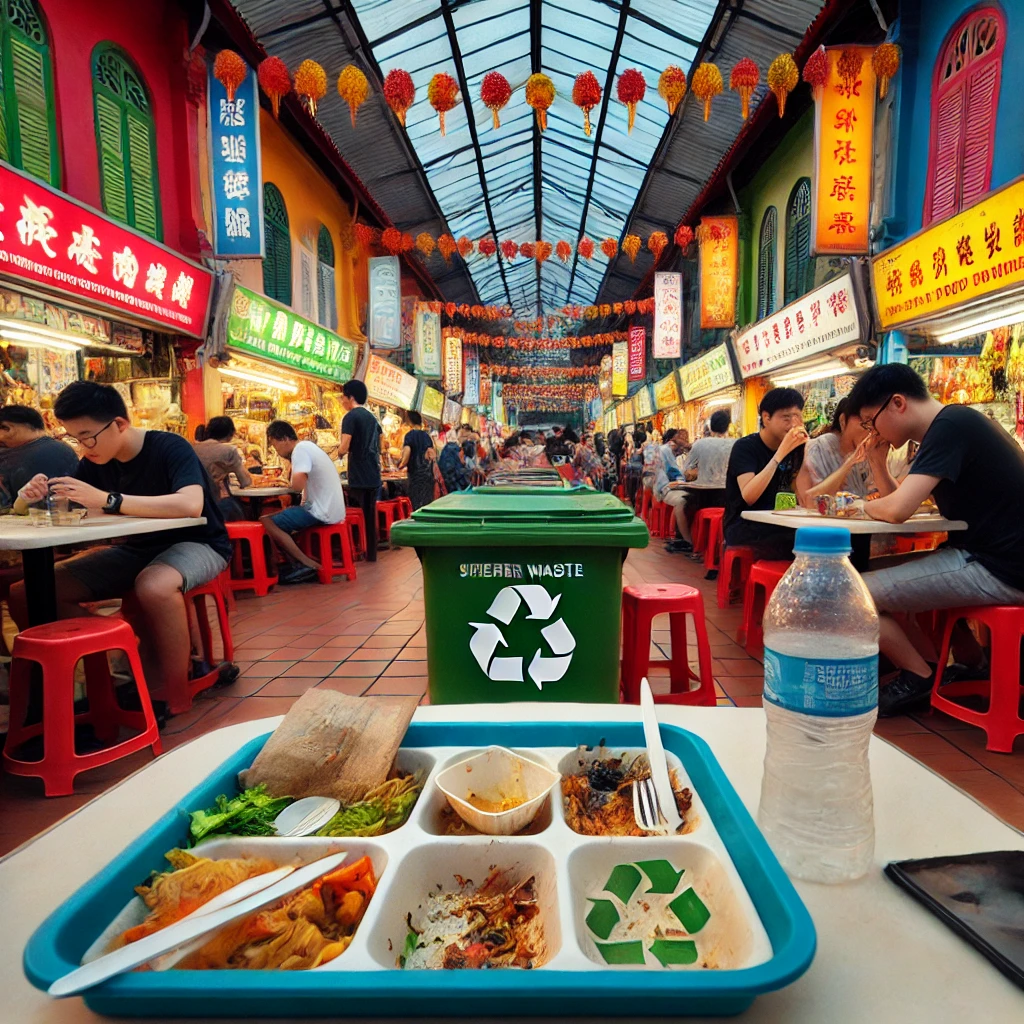Introduction to Chinatown Hawker Leftovers Consumption
Food waste is a growing issue worldwide, and Singapore is no exception. One of the most concerning areas of food waste is in hawker centers—Singapore’s beloved open-air food courts that serve affordable and delicious local dishes. Among these, Chinatown hawker centers are some of the busiest, attracting both locals and tourists. However, a lesser-discussed topic is Chinatown hawker leftovers consumption, where uneaten food is either discarded or sometimes consumed by different groups of people.
The Scale of Food Waste in Singapore
According to the National Environment Agency (NEA), Singapore generated around 817,000 tonnes of food waste in 2022, with only 18% of it being recycled. A significant portion of this waste comes from hawker centers, restaurants, and households.
| Year | Food Waste Generated (Tonnes) | Recycling Rate (%) |
|---|---|---|
| 2019 | 744,000 | 18 |
| 2020 | 665,000 | 19 |
| 2021 | 817,000 | 18 |
This table highlights the challenge Singapore faces in reducing food waste despite efforts to improve recycling rates.
Why Do Hawker Centers Generate So Much Leftover Food?
Several factors contribute to the high levels of food waste at Chinatown hawker centers:
- Oversized Portions – Many hawker stalls serve generous portions, leading to uneaten food being left on trays and plates.
- Strict Food Safety Regulations – Once food is cooked, it must be sold or discarded at the end of the day. Leftovers cannot be stored for resale due to hygiene concerns.
- Consumer Habits – Some diners over-order and leave behind unfinished meals, while others refuse to take away leftovers.
- Rejection of Imperfect Food – Hawker stall owners often discard food that doesn’t meet visual appeal standards, even if it is still edible.
Who Consumes Chinatown Hawker Leftovers?
While many hawker leftovers are discarded, some individuals and groups engage in leftover consumption for various reasons:
- Low-income individuals – Some financially struggling people take uneaten food from tables or trays to avoid going hungry.
- Freegans and sustainability activists – Ethical freegans reject food waste and choose to consume safe, uneaten leftovers.
- Hawker stall owners and workers – In some cases, workers take home unsold food instead of throwing it away.
This raises important ethical, legal, and health considerations, which we will explore further in the article.
Why This Topic Matters
Discussing Chinatown hawker leftovers consumption is crucial because:
- It highlights the food waste problem in one of Singapore’s most famous dining areas.
- It raises awareness of food insecurity and how some people rely on leftovers for survival.
- It sparks conversation on sustainability efforts and potential solutions for reducing hawker food waste.
In the following sections, we will dive deeper into Chinatown’s hawker culture, the ethical and legal aspects of leftover consumption, and possible solutions to minimize food waste.
Understanding Chinatown’s Hawker Culture
What Are Hawker Centers?
Hawker centers are an integral part of Singapore’s culture, offering affordable and diverse local dishes to residents and tourists. These large open-air food courts house multiple food stalls selling everything from Hainanese chicken rice to laksa and char kway teow. Chinatown, being one of Singapore’s most vibrant districts, is home to several famous hawker centers, including:
- Maxwell Food Centre – Known for its famous Tian Tian Hainanese Chicken Rice.
- Chinatown Complex Food Centre – Singapore’s largest hawker center with over 260 stalls.
- Hong Lim Market & Food Centre – A go-to spot for traditional dishes like prawn noodles and curry chicken noodles.
These hawker centers serve thousands of customers daily, but with high traffic comes high amounts of leftover food waste.
How Much Food Is Wasted at Chinatown Hawker Centers?
Singapore’s hawker centers contribute significantly to the country’s 817,000 tonnes of annual food waste. In Chinatown, where tourists and locals often dine, the food waste problem is even more pronounced.
According to a 2019 study by the Singapore Environmental Council (SEC), food waste from hawker centers accounts for about 20% of total food waste in Singapore. The study identified three main sources of waste:
| Source of Waste | Percentage of Total Hawker Waste |
|---|---|
| Leftovers from customers | 55% |
| Unsold food by stalls | 30% |
| Food preparation waste | 15% |
These numbers indicate that more than half of the waste comes from customers leaving food behind, a key factor in Chinatown hawker leftovers consumption.
For more details on Singapore’s food waste problem, you can visit the National Environment Agency (NEA) website: www.nea.gov.sg
Who Typically Consumes Chinatown Hawker Leftovers?
Although most uneaten food at Chinatown hawker centers is discarded, certain groups consume leftovers for different reasons:
1. Low-Income and Homeless Individuals
Some homeless people and those struggling financially rely on uneaten food found on trays or tables. While this is not a widespread practice due to Singapore’s strict cleanliness standards, it does occur in isolated cases.
2. Ethical Freegans and Food Waste Activists
A small but growing freegan movement in Singapore seeks to reduce food waste by consuming discarded but safe-to-eat food. Unlike the homeless, freegans do not scavenge out of necessity but as an ethical stand against waste.
Quote from a Singapore Freegan:
“It’s heartbreaking to see perfectly edible food being thrown away. Many of us practice food rescue to reduce waste and raise awareness about sustainability.” – Member of Freegan in Singapore Facebook Group
3. Hawker Stall Owners and Workers
Some hawker stall operators take home unsold food to avoid waste. However, due to strict food safety regulations, they often discard excess food instead of keeping it for later consumption.
The Growing Debate
As Chinatown hawker leftovers consumption becomes a topic of discussion, questions arise:
- Should unsold food be donated instead of thrown away?
- How can food waste in hawker centers be reduced while maintaining hygiene?
- Is there a way to legally and safely redistribute uneaten food?
In the next section, we will explore the ethics and legality of consuming hawker leftovers and what the government and hawker centers are doing to address these concerns.
The Ethics and Legality of Consuming Hawker Leftovers
Is It Legal to Take or Eat Leftovers from Chinatown Hawker Centers?
One of the biggest questions surrounding Chinatown hawker leftovers consumption is its legality. Singapore has strict food safety regulations, and while there is no direct law against taking leftovers from trays or tables, several laws indirectly discourage this practice:
1. Environmental Public Health Act (EPHA)
The EPHA enforces strict cleanliness and hygiene standards in public food establishments, including hawker centers. Scavenging for food from trays or tables could be seen as a public health risk, potentially violating these regulations.
2. Public Nuisance Act
Individuals rummaging through leftovers may attract attention, leading to complaints from diners and stall owners. Under Singapore’s Public Nuisance Act, behaviors that cause public annoyance or discomfort can result in fines or warnings.
3. Hawker Centre Regulations
Hawker centers are managed by agencies such as the National Environment Agency (NEA). Many have automated tray return systems or dedicated cleaning staff, meaning any leftover food is quickly cleared and discarded. Attempting to take food from cleared trays may be considered tampering with waste, which is discouraged in many public areas.
Ethical Considerations of Consuming Hawker Leftovers
Beyond legal concerns, is it ethically acceptable to take and eat hawker leftovers? The debate touches on several perspectives:
1. Public Perception and Social Stigma
In Singapore’s clean and orderly society, eating food left behind by strangers is socially frowned upon. Many see it as unhygienic, disrespectful, or even shameful. Public reactions to people consuming hawker leftovers range from silent disapproval to outright confrontation.
Case Study: In 2018, a Singaporean blogger shared a video of a man eating leftovers from plates at a hawker center. While some supported his actions for reducing food waste, others criticized it as unsanitary and inappropriate.
2. Stall Owners’ Perspectives
Most hawker stall owners do not support people eating leftovers because:
- It raises hygiene concerns, as leftover food may be contaminated.
- It reflects poorly on their business, making it seem like people are scavenging for food.
- They fear legal repercussions if someone falls sick from eating their food.
3. Balancing Food Waste and Dignity
While reducing food waste is a noble cause, the dignity of those consuming leftovers must be considered. Many argue that structured food redistribution programs (like donating unsold food) are a better alternative than allowing people to take leftovers from tables.
The Government’s Stance on Food Redistribution
To combat food waste legally and ethically, the Singaporean government has encouraged controlled food donation programs.
- The Good Samaritan Food Donation Bill – Proposed in 2019, this bill aims to protect food donors from liability if they donate food in good faith.
- Food Bank Singapore & Willing Hearts – These organizations rescue and distribute surplus but safe food to low-income individuals.
For more information on Singapore’s food waste laws and donation guidelines, visit the National Environment Agency (NEA): www.nea.gov.sg
Key Takeaways
✅ Taking leftovers from tables is not explicitly illegal, but it is discouraged due to hygiene laws and public perception.
✅ Hawker stall owners and the public generally oppose leftover consumption, preferring structured food donation initiatives.
✅ Government efforts are focused on redistributing unsold food through charities rather than allowing direct leftover consumption.
In the next section, we will explore why people consume Chinatown hawker leftovers, including economic, environmental, and personal reasons.
Why Do People Consume Chinatown Hawker Leftovers?
The practice of Chinatown hawker leftovers consumption is driven by a mix of economic, environmental, and personal reasons. While it remains a controversial topic, those who engage in it often cite compelling motivations.
Economic Reasons – Financial Hardship and Survival
Singapore is one of the most expensive cities in the world, and while it has strong social welfare programs, some individuals struggle to afford daily meals.
1. Low-Income and Homeless Individuals
For those living in financial distress, particularly the homeless and elderly poor, food security is a daily challenge. With limited income, some resort to eating uneaten hawker food as a means of survival.
Fact: According to a 2019 Oxfam Report, Singapore ranks bottom in food affordability among high-income nations, highlighting struggles faced by lower-income groups.
2. Migrant Workers with Low Wages
Singapore’s migrant workers, particularly those in construction and domestic work, earn low wages and often send most of their income back home. Some try to cut costs by scavenging leftover food, though this is uncommon due to cultural stigma and hygiene concerns.
Environmental and Sustainability Reasons
Beyond economic struggles, some individuals consume hawker leftovers as part of a larger movement against food waste.
1. Freeganism and Anti-Waste Activism
The freegan community in Singapore opposes consumerism and food waste by adopting alternative consumption habits, including:
- Dumpster diving – Collecting discarded but edible food from supermarkets and restaurants.
- Taking hawker leftovers – Consuming unfinished food left behind at public eating places.
- Food-sharing groups – Organizing events where people redistribute surplus food instead of wasting it.
Quote from a Singaporean Freegan:
“Seeing how much food is wasted daily at hawker centers is shocking. If something is still safe to eat, why throw it away?” – Member of Freegan in Singapore Facebook group.
2. Climate Change Awareness
Food waste contributes to greenhouse gas emissions and landfill overflow. By reducing waste at hawker centers, consumers can minimize their carbon footprint.
Fact: According to the National Environment Agency (NEA), food waste contributes to 8-10% of global carbon emissions, making it a major environmental issue.
Cultural and Psychological Reasons
Some people who engage in Chinatown hawker leftovers consumption do so due to habit, upbringing, or psychological beliefs.
1. “Waste Not, Want Not” Mentality
Older generations in Singapore, especially those who lived through hardships like World War II, were taught to never waste food. This deeply ingrained mindset leads some to consume leftover food out of principle rather than necessity.
2. Minimalist and Anti-Consumerist Lifestyles
Some individuals believe that modern society over-consumes and wastes resources unnecessarily. To combat this, they adopt extreme minimalism—including eating leftovers rather than buying new meals.
3. Psychological Thrill or Experimentation
A small percentage of people may try consuming leftovers for the thrill, social experiments, or as a challenge to push societal norms. Some YouTubers and bloggers document their experiences to raise awareness about food waste.
Key Takeaways
✅ Economic hardship drives some people to consume Chinatown hawker leftovers for survival.
✅ Environmental activists and freegans engage in this practice to fight food waste.
✅ Cultural and psychological factors also influence people’s attitudes towards consuming leftovers.
In the next section, we will discuss health and safety concerns related to consuming hawker leftovers.
Health and Safety Concerns of Consuming Chinatown Hawker Leftovers
While some individuals consume Chinatown hawker leftovers, there are significant health risks involved. Singapore has strict food hygiene standards, and consuming food that has been left behind by others exposes individuals to bacteria, viruses, and potential contamination.
Health Risks of Eating Leftovers from Public Hawker Centers
1. Bacterial Contamination
Once food is left out in the open, it becomes susceptible to bacterial growth. Common foodborne bacteria include:
| Bacteria | Symptoms | Common Sources |
|---|---|---|
| Salmonella | Diarrhea, fever, cramps | Poultry, eggs, raw vegetables |
| E. coli | Severe stomach cramps, vomiting | Undercooked beef, contaminated water |
| Staphylococcus aureus | Nausea, vomiting, diarrhea | Food left at room temperature too long |
| Listeria | Fever, muscle aches, confusion | Dairy, cold meats, contaminated leftovers |
Fact: According to the World Health Organization (WHO), food left at room temperature for more than 2 hours can harbor dangerous levels of bacteria.
2. Viral Contamination
Hawker centers are high-traffic public spaces, meaning that uneaten food may be exposed to viruses from coughing, sneezing, or unclean hands.
- Hepatitis A and Norovirus can spread through contaminated food.
- Leftover food may have been touched by multiple people, increasing the risk of infection.
3. Cross-Contamination from Surfaces and Pests
Food left behind on tables can be contaminated by unclean surfaces, tray return areas, or even pests like cockroaches and rats.
- A 2022 report by Singapore’s National Environment Agency (NEA) found that hawker centers with poor waste disposal attract pests, increasing the risk of contamination.
- Public eating areas are regularly disinfected, but leftover food sitting on a table can easily pick up bacteria from unsanitary surfaces.
Food Safety Regulations in Singapore
Singapore has one of the world’s strictest food safety systems under the Singapore Food Agency (SFA) and the National Environment Agency (NEA). These agencies enforce regulations to prevent foodborne illnesses.
1. NEA’s Hawker Centre Hygiene Grading
All hawker stalls in Singapore must display an A to D hygiene grade based on inspections. However, hygiene grades apply only to food prepared fresh—not to leftovers.
2. Tray Return and Cleaning Policies
To maintain hygiene, NEA enforces tray return policies where customers must return trays to designated stations. This system ensures that leftovers are quickly discarded, reducing the chances of scavenging.
Fact: Singapore’s Tray Return Initiative aims to clear uneaten food within 5–10 minutes, preventing potential contamination.
3. No Legal Protection for Consuming Leftovers
Unlike structured food donation programs where surplus food is handled safely, consuming random leftovers is unregulated and risky. If a person falls ill from eating discarded hawker food, there is no legal recourse or protection.
Can Hawker Leftovers Be Safely Repurposed?
Given the risks, are there safe ways to repurpose uneaten hawker food?
✅ Food Redistribution Programs – Some organizations, like Food Bank Singapore, collect unsold (not leftover) hawker food for donation.
✅ Technology Solutions – Apps like Treatsure help people purchase surplus food at discounted prices, preventing waste before it reaches tables.
❌ Direct Leftover Consumption – Unsafe due to hygiene risks, lack of regulation, and potential disease transmission.
Key Takeaways
✅ Leftover hawker food is unsafe due to bacterial and viral contamination.
✅ Singapore has strict food safety laws that discourage scavenging for hygiene reasons.
✅ Programs like food donation initiatives provide a safer alternative to leftover consumption.
In the next section, we will explore alternative solutions to reduce food waste in Chinatown hawker centers.
Alternative Solutions to Reduce Food Waste in Chinatown Hawker Centers
Instead of relying on Chinatown hawker leftovers consumption, there are safer and more effective ways to tackle food waste. Various government initiatives, tech solutions, and community-driven programs are working to reduce hawker food waste in Singapore.
Government and Non-Profit Initiatives to Reduce Hawker Food Waste
The Singaporean government has introduced several policies and programs to cut down on food wastage, particularly in hawker centers.
1. Singapore’s Zero Waste Masterplan
Launched in 2019, this initiative aims to reduce food waste by 30% by 2030. It includes:
- Food waste recycling programs for hawker centers.
- Surplus food donation incentives.
- Public awareness campaigns on responsible food consumption.
Fact: Singapore generated 744,000 tonnes of food waste in 2019. With better waste management, 20% of this could have been saved.
2. Hawker Centre Food Waste Recycling Programme
Some hawker centers participate in a food waste treatment initiative where unsold or leftover food is:
- Collected separately from general waste.
- Converted into bio-fertilizer or compost instead of going to landfills.
- Used to generate energy through food digesters.
Example: In 2021, the NEA piloted food waste recycling in 7 hawker centers, turning food scraps into compost for urban farming.
3. Food Bank Singapore and Its Surplus Food Redistribution
Food Bank Singapore works with restaurants, hotels, and hawkers to collect excess food before it becomes waste. They distribute safe, surplus food to:
- Low-income families
- Elderly individuals
- Welfare organizations
To learn more or support their cause, visit www.foodbank.sg.
Technology and Business Solutions for Reducing Hawker Food Waste
Innovative tech-driven solutions help hawkers, consumers, and food businesses minimize food waste without resorting to scavenging leftovers.
1. Mobile Apps for Surplus Food Sales
Several apps allow consumers to purchase unsold but fresh food from hawkers and restaurants at discounted prices:
| App Name | How It Works | Where to Download |
|---|---|---|
| Treatsure | Buy surplus food from hawkers & hotels | treatsure.co |
| OLIO | Share or collect excess food from neighbors | olioex.com |
| SG Food Rescue | Community-based food sharing | Facebook & Telegram groups |
Case Study: In 2022, Treatsure saved over 150,000 portions of food from being wasted by connecting consumers with surplus meals.
2. AI-Powered Food Waste Tracking for Hawkers
Some hawker stalls use AI-driven analytics to:
- Track which dishes have the highest leftover rates.
- Adjust portion sizes to reduce excess waste.
- Predict demand to avoid over-preparing food.
Example: NTU Singapore developed a smart AI system for hawker centers to reduce food wastage through predictive analytics.
Consumer Habits That Help Reduce Hawker Food Waste
1. Order Only What You Can Eat
As a consumer, there are simple habits you can adopt to prevent food waste before it becomes leftovers.
- Avoid over-ordering dishes, especially at buffets and mixed rice stalls.
- If unsure about portion sizes, ask for smaller portions.
2. Use Takeaway and “Bring Your Own Container” (BYOC) Options
- If you can’t finish your meal, pack leftovers instead of leaving them behind.
- Some hawker centers encourage BYOC to reduce packaging waste.
Fact: Singaporeans throw away 68,000 tonnes of cooked rice and noodles yearly—most of which comes from unfinished meals.
3. Support Businesses That Implement Sustainable Practices
- Choose hawker stalls that participate in food waste reduction initiatives.
- Support businesses using surplus food apps.
Key Takeaways
✅ Government and non-profits are actively tackling food waste through recycling and food redistribution.
✅ Apps like Treatsure and OLIO help consumers access surplus food safely.
✅ Consumers can help by ordering wisely, using takeaway options, and supporting sustainable hawkers.
In the final section, we will explore the future of food waste reduction in Chinatown hawker centers and the role of policy changes in shaping this issue.
The Future of Food Waste Reduction in Chinatown Hawker Centers
The issue of Chinatown hawker leftovers consumption highlights a bigger challenge—how to balance food security, sustainability, and public health in Singapore’s hawker culture. Moving forward, government policies, technological advancements, and community efforts will play a crucial role in minimizing food waste.
What Can Be Done to Further Reduce Hawker Food Waste?
Despite ongoing efforts, there is still room for improvement in tackling food waste at hawker centers. Future strategies may include:
1. Strengthening Food Redistribution Policies
- Encourage hawker stalls to donate surplus food instead of discarding it.
- Create tax incentives for businesses that contribute to food donation programs.
- Expand community fridges in Chinatown and other areas where people can drop off and collect excess food.
Example: The “Community Fridge Initiative” in Singapore has helped redistribute food safely to those in need, reducing waste.
2. AI and Smart Technology for Food Waste Management
- Smart food tracking systems can help hawkers monitor demand and avoid over-preparing meals.
- Food freshness sensors could be installed in hawker stalls to alert vendors when food is nearing expiry.
Case Study: A study by the National University of Singapore found that smart waste tracking systems could reduce hawker food waste by 20%.
3. Public Education on Food Waste Awareness
- Introduce food waste education in schools to encourage responsible eating habits from a young age.
- Run public campaigns on food waste reduction and its impact on the environment.
- Promote ethical consumption to change mindsets about food value and waste.
Fact: A survey by the Singapore Environment Council found that 6 in 10 Singaporeans admit to over-ordering food, contributing to unnecessary waste.
Will Chinatown Hawker Leftovers Consumption Disappear?
Given the risks and growing food sustainability efforts, the practice of consuming hawker leftovers may decline over time. Factors that could lead to its disappearance include:
✅ Stronger enforcement of tray return and cleaning policies reducing access to leftovers.
✅ More affordable food options through food-sharing apps and surplus meal programs.
✅ Better awareness about the health risks of eating unverified leftovers.
However, unless food security issues and income inequality are fully addressed, some individuals may continue to rely on scavenged food for survival.
Final Thoughts – A Holistic Approach to Food Waste
Instead of focusing solely on whether people should consume Chinatown hawker leftovers, the bigger question should be:
How can Singapore create a sustainable and waste-free food culture while ensuring food security for all?
Key Takeaways
✅ The future of food waste reduction lies in policy improvements, AI technology, and public education.
✅ Chinatown hawker leftovers consumption may decrease as more structured solutions emerge.
✅ A holistic approach—balancing food security, sustainability, and ethical responsibility—is key to tackling this issue.
Call to Action: What Can You Do?
- Reduce personal food waste by ordering only what you need.
- Support sustainable hawker stalls that participate in waste reduction programs.
- Use food-sharing apps like Treatsure to access surplus meals instead of relying on scavenged food.
- Donate to organizations like Food Bank Singapore that help redistribute food safely.
For more information on food waste reduction in Singapore, visit NEA’s official website.



